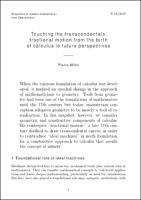| dc.contributor.author | Milici, Pietro | |
| dc.contributor.editor | Randecker, Anja | |
| dc.contributor.editor | Munday, Sara | |
| dc.contributor.editor | Jahns, Sophia | |
| dc.date.accessioned | 2019-11-21T13:03:12Z | |
| dc.date.available | 2019-11-21T13:03:12Z | |
| dc.date.issued | 2019-11-21 | |
| dc.identifier.uri | http://publications.mfo.de/handle/mfo/3685 | |
| dc.description.abstract | When the rigorous foundation of calculus was developed,
it marked an epochal change in the approach
of mathematicians to geometry. Tools from geometry
had been one of the foundations of mathematics
until the 17th century but today, mainstream conception
relegates geometry to be merely a tool of visualization.
In this snapshot, however, we consider
geometric and constructive components of calculus.
We reinterpret “tractional motion”, a late 17th century
method to draw transcendental curves, in order
to reintroduce “ideal machines” in math foundation
for a constructive approach to calculus that avoids
the concept of infinity. | en_US |
| dc.language.iso | en | en_US |
| dc.publisher | Mathematisches Forschungsinstitut Oberwolfach | en_US |
| dc.relation.ispartofseries | Snapshots of modern mathematics from Oberwolfach;2019,13 | |
| dc.rights | Attribution-ShareAlike 4.0 International | * |
| dc.rights.uri | http://creativecommons.org/licenses/by-sa/4.0/ | * |
| dc.title | Touching the transcendentals: tractional motion from the bir th of calculus to future perspectives | en_US |
| dc.type | Article | en_US |
| dc.identifier.doi | 10.14760/SNAP-2019-013-EN | |
| local.series.id | SNAP-2019-013-EN | en_US |
| local.subject.snapshot | Algebra and Number Theory | en_US |
| local.subject.snapshot | Analysis | en_US |
| local.subject.snapshot | Geometry and Topology | en_US |
| dc.identifier.urn | urn:nbn:de:101:1-2019112812102718989210 | |
| dc.identifier.ppn | 1683715845 | |


